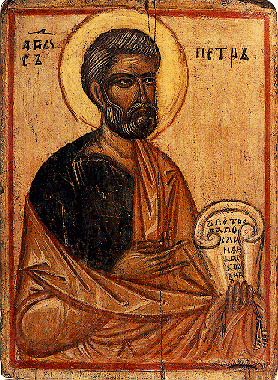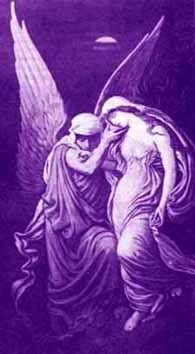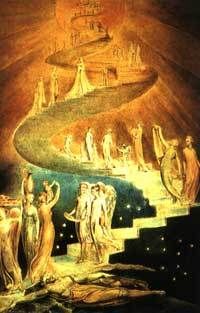Important terms and concepts
Aeons Aeon
In many Gnostic systems, the various emanations of the God, who is also known by such names as the One, the Monad, Aion teleos (The Perfect Aeon), Bythos (Depth or profundity, Greek Βυθος), Proarkhe (Before the Beginning, Greek προαρχη), E Arkhe (The Beginning, Greek ἡ ἀρχή), are called aeons. This first being is also an æon and has an inner being within itself, known as Ennoia (Thought), Charis (Grace), or Sige (Greek Σιγη, Silence). The split perfect being conceives the second aeon, Caen (Power), within itself. Along with the male Caen comes the female æon Akhana (Truth, Love).
The aeons often came in male/female pairs called syzygies, and were numerous (20-30). Two of the most commonly listed æons were Jesus and Sophia. The aeons constitute the pleroma, the "region of light". The lowest regions of the pleroma are closest to the darkness; that is, the physical world.
When an æon named Sophia emanated without her partner aeon, the result was the Demiurge, or half-creator (Occasionally referred to as Ialdaboth in Gnostic texts), a creature that should never have come into existence. This creature does not belong to the pleroma, and the One emanates two savior æons, Christ and the Holy Spirit to save man from the Demiurge. Christ then took the form of the man, Jesus, in order to be able to teach man how to achieve gnosis; that is, return to the pleroma.
These systems, however, are only a sample of the various interpretations that exist. The roles of familiar beings such as Jesus Christ, Sophia, and the Demiurge usually share the same general themes between systems but may have somewhat different functions or identities ascribed to them.
Archon Archon
In late antiquity some variants of Gnosticism used the term Archon to refer to several servants of the Demiurge, the "creator god" that stood between spiritual humanity and a transcendent God that could only be reached through gnosis. In this context they may be seen as having the roles of the angels and demons of the Old Testament.
The Ophites accepted the existence of seven archons: Iadabaoth or Ialdabaoth (who created the six others), Iao, Sabaoth, Adonaios, Elaios, Astaphanos and Horaios (Origen, Contra Celsum, VI.31). Ialdabaoth had a head of a lion, just like Mithraic Kronos (Chronos) and Vedic Narasimha, a form of Vishnu.
Abraxas/Abrasax Abraxas

The word Abraxas was engraved on certain antique stones, called on that account Abraxas stones, which may have been used as amulets or charms by Gnostic sects. In popular culture, Abraxas is sometimes considered the name of a god who incorporated both Good and Evil (God and Demiurge) in one entity, and therefore representing the monotheistic God, singular, but (unlike, for example, the Christian God) not omni-benevolent (See Hesse's Demian, and Jung's Seven Sermons to the Dead). Opinions abound on Abraxas, who in recent centuries has been claimed to be both an Egyptian god and a demon, sometimes even being associated with the dual nature of Satan/Lucifer. The word abracadabra may be related to Abraxas.
The above information relates to interpretations of ancient amulets and to reports of Christian heresy hunters which are not always clear.
Actual ancient Gnostic texts from the Nag Hammadi Library, such as the Coptic Gospel of the Egyptians, refer to Abrasax as an Aeon dwelling with Sophia and other Aeons of the Spiritual Fullness in the light of the luminary Eleleth. In several texts, the luminary Eleleth is the last of the luminaries (Spiritual Lights) that come forward, and it is the Aeon Sophia, associated with Eleleth, who encounters darkness and becomes involved in the chain of events that leads to the Demiurge and Archon's rule of this world, and the salvage effort that ensues. As such, the role of Aeons of Eleleth, including Abrasax, Sophia, and others, pertains to this outer border of the Divine Fullness that encounters the ignorance of the world of Lack and interacts to rectify the error of ignorance in the world of materiality.
Words like or similar to Abraxas or Abrasax also appear in the Greek Magical Papyri. There are similarities and differences between such figures in reports about Basiledes' teaching, in the larger magical traditions of the Graeco-Roman world, in the classic ancient Gnostic texts such as the Gospel of the Egyptians, and in later magical and esoteric writings.
The Swiss Psychologist Carl Jung wrote a short Gnostic treatise in 1916 called The Seven Sermons to the Dead, which called Abraxas a God higher than the Christian God and Devil, that combines all opposites into one Being.
Demiurge: Demiurge

The term Demiurge refers to an entity (usually seen as evil) responsible for the creation of the physical universe and the physical aspect of humanity.
The term occurs in a number of other religious and philosophical systems, most notably Platonism. While always suggestive of a creator god, the moral judgements regarding the demiurge vary wildly, from a benign grand architect to an evil subvertor of God's will.
Like Plato, Gnosticism presents a distinction between the highest, unknowable "alien God" and the demiurgic "creator" of the material. However, in contrast to Plato, several systems of Gnostic thought present the Demiurge as antagonistic to the will of the Supreme God: his act of creation either in unconscious imitation of the divine model, and thus fundamentally flawed, or else formed with the malevolent intention of entrapping aspects of the divine in materiality. Thus, in such systems, the Demiurge acts as a solution to the problem of evil. In the Apocryphon of John (several versions of which are found in the Nag Hammadi library), the Demiurge has the name "Yaltabaoth", and proclaims himself as God:
- "Now the archon who is weak has three names. The first name is Yaltabaoth, the second is Saklas, and the third is Samael. And he is impious in his arrogance which is in him. For he said, 'I am God and there is no other God beside me,' for he is ignorant of his strength, the place from which he had come."
Gnostic myth recounts that Sophia (Greek, literally meaning "wisdom"), the Demiurge's mother and a partial aspect of the divine Pleroma or "Fullness", desired to create something apart from the divine totality, and without the receipt of divine assent. In this abortive act of separate creation, she gave birth to the monstrous Demiurge and, being ashamed of her deed, she wrapped him in a cloud and created a throne for him within it. The Demiurge, isolated, did not behold his mother, nor anyone else, and thus concluded that only he himself existed, being ignorant of the superior levels of reality that were his birth-place.
The Gnostic myths describing these events are full of intricate nuances portraying the declination of aspects of the divine into human form; this process occurs through the agency of the Demiurge who, having stolen a portion of power from his mother, sets about a work of creation in unconscious imitation of the superior Pleromatic realm. Thus Sophia's power becomes enclosed within the material forms of humanity, themselves entrapped within the material universe: the goal of Gnostic movements was typically the awakening of this spark, which permitted a return by the subject to the superior, non-material realities which were its primal source. (See Sethian Gnosticism.)
"Samael" may equate to the Judaic Angel of Death, and corresponds to the Christian demon of that name, as well as Satan. Literally, it can mean "Blind God" or "God of the Blind" in Aramaic (Syriac sæmʕa-ʔel). Another alternative title for Yaldabaoth, "Saklas", is Aramaic for "fool" (Syriac sækla "the foolish one").
Some Gnostic philosophers identify the Demiurge with Yahweh, the God of the Old Testament, in opposition and contrast to the God of the New Testament. Still others equated the being with Satan. Catharism apparently inherited their idea of Satan as the creator of the evil world directly or indirectly from Gnosticism.
Gnosis: Gnosis
The word 'Gnosticism' is a modern construction, though based on an antiquated linguistic expression: it comes from the Greek word meaning 'knowledge', gnosis (γνῶσις). However, gnosis itself refers to a very specialised form of knowledge, deriving both from the exact meaning of the original Greek term and its usage in Platonist philosophy.
Unlike modern English, ancient Greek was capable of discerning between several different forms of knowing. These different forms may be described in English as being propositional knowledge, indicative of knowledge acquired indirectly through the reports of others or otherwise by inference (such as "I know of George Bush" or "I know Berlin is in Germany"), and empirical knowledge acquired by direct participation or acquaintance (such as "I know George Bush personally" or "I know Berlin, having visited").
Gnosis (γνῶσις) refers to knowledge of the second kind. Therefore, in a religious context, to be 'Gnostic' should be understood as being reliant not on knowledge in a general sense, but as being specially receptive to mystical or esoteric experiences of direct participation with the divine. Indeed, in most Gnostic systems the sufficient cause of salvation is this 'knowledge of' ('acquaintance with') the divine. This is commonly identified with a process of inward 'knowing' or self-exploration, comparable to that encouraged by Plotinus (ca. 205–270 AD). However, as may be seen, the term 'gnostic' also had precedent usage in several ancient philosophical traditions, which must also be weighed in considering the very subtle implications of its appellation to a set of ancient religious groups.
Monad (apophatic theology) Monad (Gnosticism)
In many Gnostic systems (and heresiologies), God is known as the Monad, the One, The Absolute, Aion teleos (The Perfect Æon), Bythos (Depth or Profundity, Βυθος), Proarkhe (Before the Beginning, προαρχη), and E Arkhe (The Beginning, η αρχη). God is the high source of the pleroma, the region of light. The various emanations of God are called æons.
Within certain variations of Gnosticism, especially those inspired by Monoimus, the Monad was the highest God which created lesser gods, or elements (similar to æons).
According to Hippolytus, this view was inspired by the Pythagoreans, who called the first thing that came into existence the Monad, which begat the dyad, which begat the numbers, which begat the point, begetting lines, etc. This was also clarified in the writings of Plato, Aristotle and Plotinus. This teaching being largely Neopythagorean via Numenius as well.
This Monad is the spiritual source of everything which emanates the pleroma, and could be contrasted to the dark Demiurge (Yaldabaoth) that controls matter.
The Sethian cosmogony as most famously contained in the Apocryphon ('Secret book') of John describes an unknown God, very similar to the orthodox apophatic theology, although very different from the orthodox credal teachings that there is one such god who is identified also as creator of heaven and earth. In describing the nature of a creator god associated with Biblical texts, orthodox theologians often attempt to define God through a series of explicit positive statements, themselves universal but in the divine taken to their superlative degrees: he is omniscient, omnipotent and truly benevolent. The Sethian conception of the most hidden transcendent God is, by contrast, defined through negative theology: he is immovable, invisible, intangible, ineffable; commonly, 'he' is seen as being hermaphroditic, a potent symbol for being, as it were, 'all-containing'. In the Apocryphon of John, this god is good in that it bestows goodness. After the apophatic statements, the process of the Divine in action are used to describe the effect of such a god.
An apophatic approach to discussing the Divine is found throughout gnosticism, Vedanta, and Platonic and Aristotelian theology as well. It is also found in some Judaic sources.
Pleroma Pleroma
Pleroma (Greek πληρωμα) generally refers to the totality of God's powers. The term means fullness, and is used in Christian theological contexts: both in Gnosticism generally, and in Colossians 2.9.
Gnosticism holds that the world is controlled by evil archons, one of whom is the demiurge, the deity of the Old Testament who holds the human spirit captive.
The heavenly pleroma is the center of divine life, a region of light "above" (the term is not to be understood spatially) our world, occupied by spiritual beings such as aeons (eternal beings) and sometimes archons. Jesus is interpreted as an intermediary aeon who was sent from the pleroma, with whose aid humanity can recover the lost knowledge of the divine origins of humanity. The term is thus a central element of Gnostic cosmology.
Pleroma is also used in the general Greek language and is used by the Greek Orthodox church in this general form since the word appears under the book of Colossians. Proponents of the view that Paul was actually a gnostic, such as Elaine Pagels of Princeton University, view the reference in Colossians as something that was to be interpreted in the gnostic sense.
Sophia Sophia (wisdom)
In Gnostic tradition, the term Sophia (Σoφíα, Greek for "wisdom") refers to the final and lowest emanation of God.
In most if not all versions of the gnostic myth, Sophia births the demiurge, who in turn brings about the creation of materiality. The positive or negative depiction of materiality thus resides a great deal on mythic depictions of Sophia's actions. She is occasionally referred to by the Hebrew equivalent of Achamoth (this is a feature of Ptolemy's version of the Valentinian gnostic myth). Jewish Gnosticism with a focus on Sophia was active by 90.[citation needed]
Almost all gnostic systems of the Syrian or Egyptian type taught that the universe began with an original, unknowable God, referred to as the Parent or Bythos, as the Monad by Monoimus, or the first Aeon by still other traditions. From this initial unitary beginning, the One spontaneously emanated further Aeons, pairs of progressively 'lesser' beings in sequence. The lowest of these pairs were Sophia and Christ. The Aeons together made up the Pleroma, or fullness, of God, and thus should not be seen as distinct from the divine, but symbolic abstractions of the divine nature.










No comments:
Post a Comment